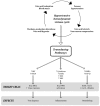Chronic Venous Disorders: The Dangerous, the Good, and the Diverse
- PMID: 30154324
- PMCID: PMC6164218
- DOI: 10.3390/ijms19092544
Chronic Venous Disorders: The Dangerous, the Good, and the Diverse
Abstract
Chronic venous disorders are common vascular pathology of great medical and socioeconomic impact, characterized by a wide spectrum of clinical manifestations occurring with symptoms and/or signs that vary in type and severity. The predominant pathophysiological mechanisms of chronic venous disease start from the development of venous hypertension from shear stress and reflux, leading to endothelial dysfunction and venous wall dilatation. The altered hemodynamic transduces physical signals into harmful bio-molecular pathways, creating a vicious cycle among shear stress, proteolytic remodeling, and inflammatory processes. This intricate network is further exacerbated by the degradation of protective endothelial glycocalyx. In this special issue, at least three main aspects of these interactions are highlighted: the dangerous, the good, and the diverse, which may help to focus attention on the biomolecular mechanisms and the possible targeted therapy of chronic venous disorders (CVeD).
Keywords: biomarkers; chronic venous disorders; chronic venous insufficiency; cytokines; glycocalyx; glycosaminoglycan; inflammation; matrix metalloproteinases; venous leg ulcer; wound healing.
Conflict of interest statement
The authors declare no conflict of interest.
Figures



References
-
- Raffetto J.D., Mannello F. Pathophysiology of chronic venous disease. Int. Angiol. 2014;33:212–221. - PubMed
Publication types
MeSH terms
Substances
LinkOut - more resources
Full Text Sources
Other Literature Sources
Medical

